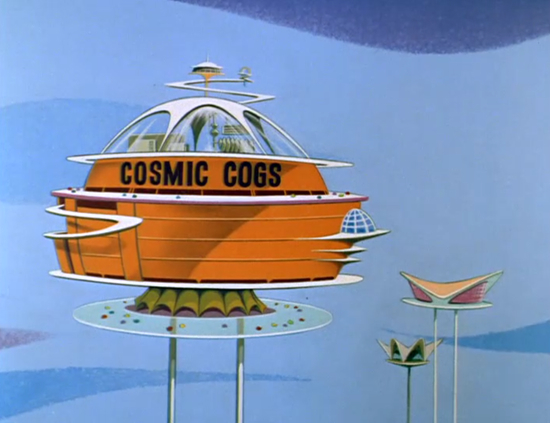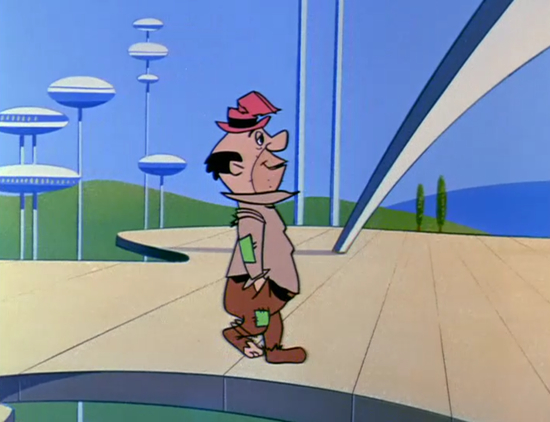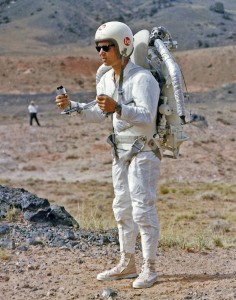Recapping ‘The Jetsons’: Episode 07 – The Flying Suit
Viewers got their first look at jetpacks as well as what actually happens on the ground beneath the Jetsons, and while it may not be zombies, it isn’t pretty
![]()
 This is the seventh in a 24-part series looking at every episode of “The Jetsons” TV show from the original 1962-63 season.
This is the seventh in a 24-part series looking at every episode of “The Jetsons” TV show from the original 1962-63 season.
The seventh episode of “The Jetsons” premiered on American television November 4, 1962, and was titled “The Flying Suit.” In this episode we’re introduced to Mr. Cogswell (we don’t learn until the 1980s that his first name is Spencer) whose company Cogswell’s Cosmic Cogs is Mr. Spacely’s direct competitor. We discover that the cigar-chomping Cogswell is trying to merge with Spacely Sprockets in a sort of 21st century semi-hostile takeover.
Cogswell’s company has developed the X-1500 flying suit which will likely force Spacely Sprockets to sell out to Cogswell, but thanks to a comedic mix-up at the 30-second dry cleaners, George winds up with the flying suit, depriving Cogswell of his invention. Both companies are confused about the source of their respective powers (and lack thereof) after the mistake at the cleaners and George is convinced that his son Elroy has developed a pill that allows people to fly.
But after both sides return to the cleaners and the mix-up is rectified (unbeknownst to both parties) the status quo is restored, with George returning to his regular job and the two companies returning to their bitter rivalry manufacturing cogs and sprockets.

Cogswell’s Cosmic Cogs, introduced in the Jetsons episode “The Flying Suit”
Life on the Ground
As I mentioned last week, the sixth episode of the series, titled “The Good Little Scouts” shows what might be our first glance at the ground. The Jetsons’ world is largely made up of many buildings on platforms in the sky — but often we get a look at something ambiguous; something that may be resting on the earth. In “The Flying Suit” we get our first look at something more clearly on the ground. Strangely enough, that something is a bird.

A bird on the ground in the seventh episode of ‘The Jetsons’ in 1962
“What’s happening on the ground?” is one of the most common questions people have when they work from vague memories of The Jetsons, having watched the show as children. Last week someone vandalized the Wikipedia page for Jetsons, inserting a story about why the people of the future live up in the sky: apparently zombies had attacked and forced people to build homes where they couldn’t be preyed upon by the undead. This, of course, isn’t true (though someone has no doubt written up this fanfic already). What is true, is that we do get a few glimpses of life on the ground in the year 2062.
Aside from the bird who has been forced to live on the ground thanks to so many humans zipping around in the sky, we learn that hobos and layabouts live on lower levels. Perhaps the more jarring revelation about meeting a character in poverty is that people can still be in such a situation a hundred years hence. It’s obviously not given a lot of screen time (and only serves to assist a joke) but the idea that poor people still exist in the year 2062 is counter to many of the post-scarcity narratives so prominent in 20th century futurism.
Americans were told, even in the depths of the Depression, that the people of the 21st century would be capable of providing for everyone; that a new form of economics would evolve wherein no one would do without the most basic of goods. In fact, people would thrive and the evolution of humanity and the American economy itself would mean that no one could go hungry. But just as the Jetsons sought to project the model American family into the future without challenging any social norms, the world of 1962 American poverty (albeit a cartoonish version of it) is projected into 2062.

A hobo living on a lower level in the seventh episode of ‘The Jetsons’ from 1962
Jetpack Lite: The Flying Suit of the Future

Bell Aerospace’s rocket belt in Hopi Buttes, Arizona (source: USGS 1966)
As we’ve seen time and again while exploring the world of “The Jetsons,” the show takes many plausible, futuristic ideas of the 1950s and early ’60s and adds a heightened cartoon twist. In this episode the idea of personal flight machines — jetpacks of the early 1960s which were becoming more plausible with each passing day — were done away with to provide a comedic storyline of futuristic travel.
Since the dawn of humanity it seems we’ve been fascinated with flight. Powered flight being a relatively recent invention, and it strikes me as something special to live in a time when we can know such common-sense-defying thrills as human flight. Yet for many retro-futurists of today, we’re still waiting on that jetpack.
Wendell F. Moore applied for a patent in 1960 and on February 13, 1962 was granted patent number 3,021,095 for his rocket belt. I use the term “jetpack” because it’s more commonly understood as the personal aircraft device that people of the retro-future would zip around on. But as Mac Montandon explains quite well in his 2008 book Jetpack Dreams, the devices researched and developed successfully at Bell Aerospace in the early 1960s are more appropriately named rocket belts.
The patent explicitly explains the desire for the rocket belt to be used by military personnel, but much like other innovations of the American military, the public expected that they would one day get a jetpack of their very own.
From the 1960 propulsion unit patent of Wendell Moore and Bell Aerospace in New York:
For a number of years, there has been a need for increasing the mobility of military personnel, for example, infantrymen, by way of providing some means to directly lift and transport an individual soldier. It is of primary concern in connection with the present invention to provide such means in the form of a safe, reliable and easily controllable rocket propulsion system having sufficient total impulse to lift and propel an individual for distances up to approximately two or three miles.
It is a further object of this invention to provide a device in accordance with the above which is capable of being utilized by the average soldier with an absolute minimum of training.
That desire to achieve “two or three miles” was the largest hurdle that the jetpack would face, as it’s not efficient to propel a person in such a manner — you simply can’t store and burn enough fuel in such a compact device to make it a practical means of transportation. Thus, the jetpack has been relegated to concerts and Super Bowls as an entertaining spectacle.

George Jetson wearing the flying suit
We may not have a jetpack, and we may not be living on platforms in the clouds, but take solace my fellow retro-futurists: the world still has 50 years to deliver on the techno-utopianism that was the promise of the Jetsons’ future.
/https://tf-cmsv2-smithsonianmag-media.s3.amazonaws.com/accounts/headshot/matt-novak-240.jpg)
/https://tf-cmsv2-smithsonianmag-media.s3.amazonaws.com/accounts/headshot/matt-novak-240.jpg)